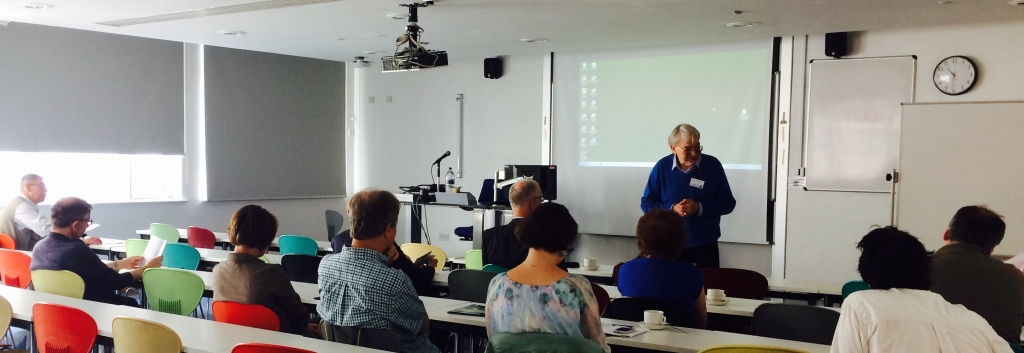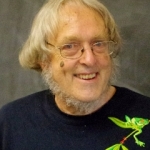 Peter Cameron is an Emeritus Professor of Mathematics in the School of Mathematical Sciences at Queen Mary, University of London. He is also a half-time Professor of Mathematics and Statistics at the University of St Andrews. Peter writes a popular blog about things he “feel(s) strongly enough about” and he recently posted an entry about his observations at the Dynamics, Functional Equations, Infinite Combinatorics and Probability Conference 2017 (12-14 June), hosted by the Department of Mathematics, London School of Economics and Political Science.
Peter Cameron is an Emeritus Professor of Mathematics in the School of Mathematical Sciences at Queen Mary, University of London. He is also a half-time Professor of Mathematics and Statistics at the University of St Andrews. Peter writes a popular blog about things he “feel(s) strongly enough about” and he recently posted an entry about his observations at the Dynamics, Functional Equations, Infinite Combinatorics and Probability Conference 2017 (12-14 June), hosted by the Department of Mathematics, London School of Economics and Political Science.
This blog post is reproduced below, with his kind permission.
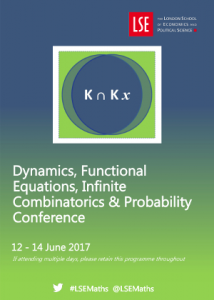 I’ve just been at a conference called “Kinks 2”, or that might be “knkx 2” (I never saw it written down)(NB from blog editor: it was KnKx2). But look at the list of topics: dynamics, functional equations, infinite combinatorics and probability. How could I resist that?
I’ve just been at a conference called “Kinks 2”, or that might be “knkx 2” (I never saw it written down)(NB from blog editor: it was KnKx2). But look at the list of topics: dynamics, functional equations, infinite combinatorics and probability. How could I resist that?
Of course, with a conference like this, the first question is: is the conference on the union of these topics, or their intersection? The conference logo strongly suggests the latter. But as usual I was ready to plunge in with something connecting with more than one of the topics. I have thought about functional equations, but only in the power series ring (or the ring of species); but it seemed to me that sum-free sets would be the best fit: there is infinite combinatorics and probability; there is no dynamics, but some of the behaviour looks as if there should be!
The organisers were Adam Ostaszewski and Nick Bingham. So the conference was centred on their common interests. I will say a bit about this in due course. Unfortunately, for personal reasons, I was not able to travel south until Monday morning, and even getting up at 6am I didn’t get to the conference room until a little after 2pm. So I missed the opening talk by Nick Bingham (which no doubt set the scene, and according to Charles Goldie was a sermon) and the talk by Jaroslav Smítal ; I arrived shortly after the first afternoon lecture, by Vladimir Bogachev, had begun.
I will try to give an overview of what I heard, but will not cover everything at the same level. Of course, a topologist, analyst or probabilist would give a very different account!
Vladimir’s talk was something which tied in to the general theme in a way I didn’t realise until later. He talked about topological vector spaces carrying measures; in such a space, consider the set of vectors along which the measure is differentiable (in one of several senses), one of which is apparently called the Cameron–Martin space. He had something called DC and explained that he originally named it after a Russian mathematician whose name began with S (in transliterated form); he had used the Cyrillic form, never imagining in those days that one day he would be lecturing about it in London!
David Applebaum talked about extending the notion of a Feller–Markov process from compact topological groups to symmetric spaces, and considering five questions that have been studied in the classical case, asking how they extend. He wrote on the board, which didn’t actually slow him down much. David said “I want to prove something”, but Nick, who was chairing, said “No, just tell the story”.
 Finally for the day, Christopher Good explained two concepts to us: shifts of finite type (this means closed subspaces of the space of sequences over a finite alphabet, closed under the shift map, and defined by finitely many excluded subwords), and shadowing (this is relevant if you are iterating some function using the computer; typically the computed value of f(xi) will not be exact, but will be a point xi+1 close to f(xi); we say that this pseudo-orbit is shadowed by the orbit of y if fi(y) is close to xi). People have known for a long time that these concepts are closely related, but he and his postdoc have a theorem to this effect. In a compact 0-dimensional space like Cantor space, their theorem says that a map has the shadowing property if and only if it is conjugate to an inverse limit of shifts of finite type. Over arbitrary compact metric spaces they also have a necessary and sufficient condition, but it is more complicated, involving the notion of semi-conjugacy. He explained that the aim of this kind of dynamics is to replace a complicated map on a simple space by a simple map (a shift) on a more complicated space (finite type).
Finally for the day, Christopher Good explained two concepts to us: shifts of finite type (this means closed subspaces of the space of sequences over a finite alphabet, closed under the shift map, and defined by finitely many excluded subwords), and shadowing (this is relevant if you are iterating some function using the computer; typically the computed value of f(xi) will not be exact, but will be a point xi+1 close to f(xi); we say that this pseudo-orbit is shadowed by the orbit of y if fi(y) is close to xi). People have known for a long time that these concepts are closely related, but he and his postdoc have a theorem to this effect. In a compact 0-dimensional space like Cantor space, their theorem says that a map has the shadowing property if and only if it is conjugate to an inverse limit of shifts of finite type. Over arbitrary compact metric spaces they also have a necessary and sufficient condition, but it is more complicated, involving the notion of semi-conjugacy. He explained that the aim of this kind of dynamics is to replace a complicated map on a simple space by a simple map (a shift) on a more complicated space (finite type).
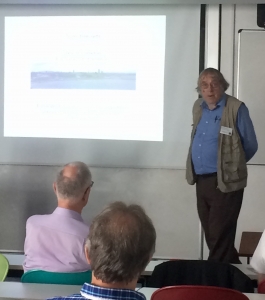 I was the first speaker next morning. I arrived half an hour early, to find the coffee laid out but nobody else around. Soon Rebecca Lumb came along and logged in to the computer, so I could load my talk. I found that the clicker provided had the feature that the left button advances the slides, so I took it out and put in my own, which works the right way round. The talk went well, and I enjoyed a gasp of surprise from the audience when I displayed my empirical approximation to the density spectrum of a random sum-free set. My last slide, a picture of an apparently non-periodic sum-free set generated by a periodic input, was also admired. It was suggested that a series of such pictures, in striking colours, would be worthy of an art exhibition. The slides are available here.
I was the first speaker next morning. I arrived half an hour early, to find the coffee laid out but nobody else around. Soon Rebecca Lumb came along and logged in to the computer, so I could load my talk. I found that the clicker provided had the feature that the left button advances the slides, so I took it out and put in my own, which works the right way round. The talk went well, and I enjoyed a gasp of surprise from the audience when I displayed my empirical approximation to the density spectrum of a random sum-free set. My last slide, a picture of an apparently non-periodic sum-free set generated by a periodic input, was also admired. It was suggested that a series of such pictures, in striking colours, would be worthy of an art exhibition. The slides are available here.
After a coffee break, Imre Leader spoke about sumsets (so not too far from my talk but not at all the same). As usual, he wrote on the board. The question was: if you colour the natural numbers with finitely many colours, is there an infinite set for which all pairwise sums have the same colour? The answer is yes if you take pairwise sums of distinct elements. (Colour the pair {i,j} with the colour of i+j. By Ramsey’s theorem, there is an infinite set with all pairs of the same colour; this does it!). The first surprise was that if you allow x+x as a sum as well, then it is impossible; he showed us the nice two-step argument for this. (The first step is simple; you can always colour so that x and 2x have different colours: take two colours, and give x the colour red if the exponent of 2 in the factorisation of x is even, blue if it is odd. The second step a bit more elaborate.) What about larger systems? He showed us why the answer is No in the integers, and No in the rationals, but (surprisingly) Yes in the reals, if you assume the Continuum Hypothesis (and indeed, Yes in a vector space of sufficiently large dimension over the rationls (precisely, bethω).
First after lunch was Dugald Macpherson, who talked about automorphism groups of countable relational structures, especially closed oligomorphic groups (and more specially, automorphism groups of homogeneous structures over finite relational languages). His talk was in three parts, of which he skipped the second for lack of time. The first part was stuff I knew well, the connection between Ramsey structures and topological dynamics (the Kechris–Pestov–Todorcevic theorem and what happened after). The second part would have been about simplicity. The third concerned the existence of “ample generics” and applications of this to many things including the small index property, uncountable cofinality, and the Bergman property, and then sufficient conditions for ample generics (with names like EPPA and APPA).
Eliza Jabłońska talked about “Haar meager sets”, an ideal of subsets of a topological group having many similarites to the Haar null setes in the case of a locally compact group. Some, but not all, of the classic results about measure and category for the real numbers go through to this situation.
Finally, Janusz Brzdęk talked about the generalised Steinhaus property. In loose terms, this says that, if A is a subset of a topological group which is “large enough and decent”, then A−A has non-empty interior, and more generally, if A is as above and B is “not small”, then A−B has non-empty interior. This kind of result has applications in the theory of functional equations, for example showing that if you have a solution of f(x+y) = f(x)+f(y) in a large enough and decent subset of G then this solution can be extended to the whole of G. There are also applications to “automatic continuity” (but I don’t know what this is). He started off with some very general results which apply in any magma (set with a binary operation) with identity. You have to redefine A−B in such a case, since inverses don’t exist; it is the set of z for which z+B intersects A. He went on to a discussion of microperiodic functions (which have arbitrarily small periods): on the reals, such a function, if continuous, must be constant, and if Lebesgue measurable, must be constant almost everywhere. There are also approximately microperiodic functions, sub-microperiodic functions, and so on.
Then off to a pleasant conference dinner at the local Thai restaurant, where conversation ranged over doing, teaching and understanding mathematics, along with many other topics.
Wednesday was a beautiful day, so I walked in to the LSE, past St Pauls and down Fleet Street.
The first speaker, Harry Miller, was talking to us by skype from Sarajevo, since his health is not good enough to allow him to make the trip. The technology worked reasonably well, though the sound quality was not great and the handwritten slides were packed with information. He gave us half a dozen different conditions saying that a subset of the unit interval is “large” (not including the well-known ones, measure 1 and residual), and a number of implications between them and applications. One nice observation: are there compact sets A and B such that A+B contains an interval but A−B doesn’t? Such sets had been constructed by “transfinite mumbo-jumbo”, but he showed us a simple direct construction: A is the set of numbers in [0,1] whose base-7 “decimal” expansion has only digits 0, 4 and 6, while B is the set using digits 0, 2 and 6.
After this, Marta Štefánková talked about hyperspace: this is the space K(X) of all compact subsets of a compact metric space X, with the Hausdorff metric. Given a map f, how do the dynamics of f on X relate to the dynamics of the induced map on K(X)? She introduced four kinds of “Li–Yorke chaos”: a map can be generically, or densely, chaotic or epsilon-chaotic. There are a number of implications between the resulting eight situations, but some non-implications as well; almost everything is known if X is the unit interval but in other cases there are still many mysteries.
Adrian Mathias, whom I haven’t seen for donkeys years, talked about connections between descriptive set theory and dynamics (he said, inspired by a trip to Barcelona, where he found the dynamicists sadly lacking in knowledge about descriptive set theory). The subtitle was “analytic sets under attack”. (The basic idea is that iteration of a map f is continued into the transfinite (I missed the explanation of how this is done), and x attacks y if there is an increasing sequence of ordinals so that the corresponding sequence of iterations of f applied to x has limit y.)
Dona Strauss talked about the space βN, the Stone–Cech compactification of the natural numbers (realised as the set of ultrafilters on the natural numbers). It inherits a semigroup structure from N, and the interplay of algebra and topology is very interesting. Her main result was that many subsets of βN which are very natural from an algebraic point of view are not Borel sets: these include the set of idempotents, the minimal ideal, any principal right ideal, and so on. (The Borel sets form a hierarchy, but any beginners’ text on descriptive set theory tells you not to worry too much, all interesting sets are Borel, and are in fact very low in the hierarchy.)
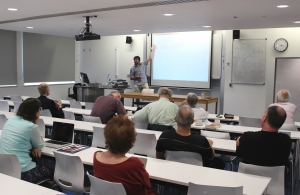 Peter Allen took time out from looking after his five-week-old baby to come and tell us about graph limits. It was a remarkable talk; I have heard several presentations of that theory, including one by Dan Kral in Durham, but Peter managed to throw new light on it by taking things in a different order. He also talked about some applications, such as a version of the theory for sparse graphs, and some major results already found using this approach: these include
Peter Allen took time out from looking after his five-week-old baby to come and tell us about graph limits. It was a remarkable talk; I have heard several presentations of that theory, including one by Dan Kral in Durham, but Peter managed to throw new light on it by taking things in a different order. He also talked about some applications, such as a version of the theory for sparse graphs, and some major results already found using this approach: these include
- a considerable simplification of the Green–Tao theorem that the primes contain arbitrarily long arithmetic progressions; and
- a solution of an old problem: given two bounded sets A, B in Euclidean space of dimension at least 3, having the same measure, each of which “covers” the other (this means finitely many congruent copies of A cover B and vice versa), there is a finite partition of A into measureable pieces, and a collection of isometries (one for each piece) so that the images of the pieces under the isometries partition B.
Finally it was time for Adam’s talk. His title was “Asympotic group actions and their limits”, but he had the brilliant subtitle for a talk at the London School of Economics and Political Science: “On quantifier easing”. He explained how the notion of regular variation had led him to various functional equations, the simplest of which is additivity, and then he had discovered that these equations were actually the same up to a twist. There was quite a lot of technical stuff, and my concentration was beginning to fade, so I didn’t catch all the details.
That was the end of the conference, and we all went our separate ways.

